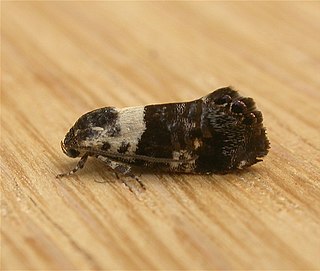Related Research Articles

Jamides bochus, the dark cerulean, is a small butterfly found in Indomalayan realm that belongs to the lycaenids or blues family. The species was first described by Caspar Stoll in 1782.

Hypolimnas misippus, the Danaid eggfly, mimic, or diadem, is a widespread species of nymphalid butterfly. It is well known for polymorphism and mimicry. Males are blackish with distinctive white spots that are fringed in blue. Females are in multiple forms that include male-like forms while others closely resemble the toxic butterflies Danaus chrysippus and Danaus plexippus. They are found across Africa, Asia, and Australia. In the new world they are found in the West Indies, with strays in Central and North America.

Eupselia aristonica is a species of moth of the family Depressariidae. It is found in Australia, where it has been recorded from New South Wales, the Australian Capital Territory, Victoria and Tasmania.

Eupselia satrapella is a species of moth of the family Depressariidae. It is found in Australia, where it has been recorded from Queensland, New South Wales and the Australian Capital Territory.
Trichoptilus scythrodes is a moth of the family Pterophoridae that can be found in Australia, including New South Wales and South Australia.
Sabatinca calliarcha is a species of moth belonging to the family Micropterigidae. It was described by Edward Meyrick in 1912. It is known from New Zealand.

Lichenaula lichenea is a species of moth of the family Xyloryctidae. It is known in Australia from the Australian Capital Territory, New South Wales and Queensland.

Izatha apodoxa is a moth of the family Oecophoridae. It is endemic to New Zealand, where it is known from scattered localities in the southern North Island. This species is variable in appearance and comes in two forms, a grey form and a black and white form. In the grey form it is very similar in appearance to I. notodoxa and in the black and white form to I. katadiktya. At present the larvae and biology of this species is unknown.
Heterocrossa gonosemana is a species of moth in the family Carposinidae. It is endemic to New Zealand.
Cosmopterix albicaudis is a moth of the family Cosmopterigidae. It is known from Jamaica, Trinidad and Tobago and the US Virgin Islands.
Cosmopterix facunda is a moth of the family Cosmopterigidae. It is known from Texas, United States.
Cosmopterix quadrilineella is a moth of the family Cosmopterigidae. It is known from the United States.
Pebobs sanctivincenti is a moth of the family Cosmopterigidae. It is known from Grenada and Saint Vincent and the Grenadines.

Glyphipterix euastera is a species of sedge moth in the genus Glyphipterix. It is endemic to New Zealand. This species is classified as "At Risk, Naturally Uncommon" by the Department of Conservation.
Stenoma platyterma is a moth of the family Depressariidae. It is found in Guyana.
Eupragia solida is a moth in the family Depressariidae. It was described by Walsingham in 1911. It is found in Mexico, where it has been recorded from Tabasco.
Eupselia callidyas is a moth in the family Depressariidae. It was described by Edward Meyrick in 1915. It is found in Australia, where it has been recorded from the Northern Territory.
Eupselia melanostrepta is a moth in the family Depressariidae. It was described by Edward Meyrick in 1880, where it has been recorded from Victoria and Tasmania.
Eupselia philomorpha is a moth in the family Depressariidae. It was described by Oswald Bertram Lower in 1902. It is found in Australia, where it has been recorded from Victoria.
Hypertropha thesaurella is a moth in the family Depressariidae. It was described by Edward Meyrick in 1880. It is found in Australia, where it has been recorded from Queensland and New South Wales.
References
- ↑ Eupselia at Markku Savela's Lepidoptera and Some Other Life Forms.
- ↑ Proceedings of the Linnean Society of New South Wales 5 (2): 222
| This article on a moth of the subfamily Hypertrophinae is a stub. You can help Wikipedia by expanding it. |